
Silver leaf is a fungal disease of trees caused by the fungal plant pathogen Chondrostereum purpureum. It attacks most species of the rose family Rosaceae, particularly the genus Prunus. The disease is progressive and often fatal. The common name is taken from the progressive silvering of leaves on affected branches. It is spread by airborne spores landing on freshly exposed sapwood. For this reason cherries and plums are pruned in summer, when spores are least likely to be present and when disease is visible. Silver Leaf can also happen on poming fruits like apples and pears. Plums are especially vulnerable.

Peniophora albobadia is a species of crust fungus in the family Peniophoraceae. It is a saprobic fungus, forming spreading crusts on the bark of decaying twigs and fallen branches of many hardwood species. The species epithet is derived from albo-, white, and badi- meaning reddish-brown, the epithet accurately describing the vivid contrast between the fertile area and the margin.

Cymatoderma is a widely distributed genus of poroid fungi in the family Meruliaceae.
Hjortstamia is a genus of corticioid fungi in the family Phanerochaetaceae. It was circumscribed by French mycologists Jacques Boidin and Gérard Gilles in 2003.

Hypochnicium is a genus of corticioid fungi in the family Meruliaceae. The genus was circumscribed by mycologist John Eriksson in 1958.

The sirex woodwasp is a species of horntail, native to Europe, Asia, and northern Africa. Adults vary in length from 9 to 36 mm.

Clavulicium is a genus of corticioid fungi in the family Stereopsidaceae. It was formerly placed in the family Clavulinaceae in the order Cantharellales but was found to belong in a new order along with Stereopsis in 2014. The widespread genus was circumscribed by the French mycologist Jacques Boidin in 1957. The spores and the basidia of species in the genus are similar to those in Clavulina but also similar to those in Stereopsis. Clavulicium globosum is now a species of Stereopsis.

Xenasma is a genus of corticioid fungi in the order Polyporales. It was circumscribed by mycologist Marinus Anton Donk in 1957.

Amylostereum is the single genus in the fungal family Amylostereaceae. The genus currently comprises four saprotrophic and parasitic species, which live off living or dead wood. The Amylostereaceae cause white rot in the wood by disintegrating the tissue component lignin. They produce crust-like, partially wavy fruit bodies on the surface of infested trees, which are similar to those produced by Stereum species.
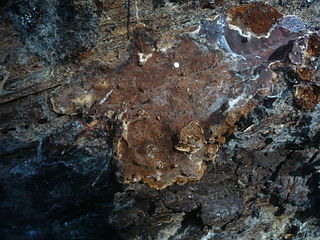
Amylostereum areolatum is a species of crust fungus. Originally called Thelephora areolata in 1828, it was given its current name by French mycologist Jacques Boidin in 1958.
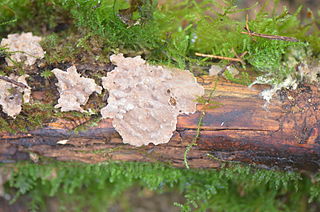
Amylostereum chailletii is a species of crust fungus. It was originally described in 1822 as Thelephora chailletii by Christian Hendrik Persoon in 1822, and given its current name when it was moved into Amylostereum by Jacques Boidin in 1958. It causes a white rot, especially in spruce and fir species.

Xylobolus frustulatus, commonly known as the ceramic fungus or ceramic parchment, is an inedible species of crust fungus in the Stereaceae family. The fruit body forms small, hard, flat crust-like aggregations that resemble broken pieces of ceramic tile. These pieces are initially whitish before turning yellow-brown to gray-brown in age. The spore-bearing cells cover the upper surfaces of the fruit body. A saprobic species, it grows on well-decayed oak wood in Asia, northern Europe, and North America.
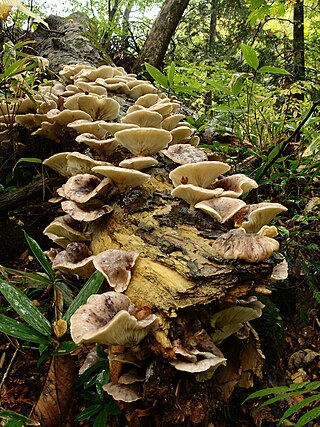
Omphalotus japonicus, commonly known as the tsukiyotake(月夜茸), is an orange to brown-colored gilled mushroom native to Japan and Eastern Asia. It is a member of the cosmopolitan genus Omphalotus, the members of which have bioluminescent fruit bodies which glow in darkness. A 2004 molecular study shows it to be most closely related to a clade composed of Omphalotus nidiformis of Australia, Omphalotus olivascens of Western North America and Omphalotus olearius of Europe.
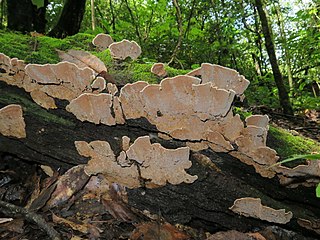
Xylobolus subpileatus is a widely distributed species of crust fungus in the family Stereaceae. It was first described scientifically in 1849 by Miles Joseph Berkeley and Moses Ashley Curtis, who considered the fungus a species of Stereum closely related to but distinct from Stereum rugosum. The original collections were made from specimens growing on dead trunks in the United States of Ohio and South Carolina. Xylobolus subpileatus was given its current name by French mycologist Jacques Boidin when he transferred it to the genus Xylobolus in 1958.
Myriothele is a fungal genus in the family Polyporaceae. It is a monotypic genus, consisting of the single species Myriothele philippiae, a toothed crust fungus found in Réunion.
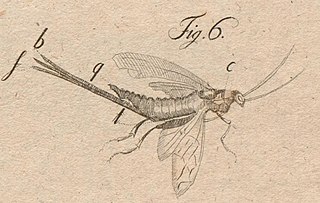
Xeris is a genus of horntails found in North America and Eurasia. Achille Costa circumscribed the genus in 1894.
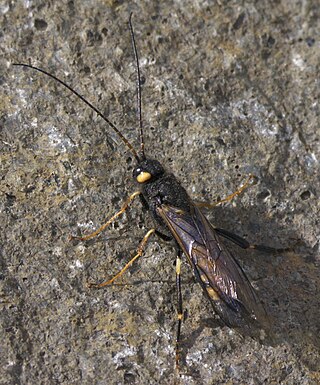
Urocerus is a genus of horntails in the family Siricidae. There are about eight described species in Urocerus.
Dentocorticium sulphurellum is a species of crust fungus in the family Polyporaceae. It is characterized by its toothed surface, its sulphur-yellow colour, and microscopically by the presence of dendrohyphidia in the hymenium. Charles Horton Peck originally described it in 1879 as Hydnum sulphurellum; it was transferred to Dentocorticium in 1974. It is found in North America and Japan.
Urocerus japonicus, commonly known as the Japanese horntail, is a species of sawfly, native to southeastern Asia. Studies show that the dispersal distance of the female is higher than the male. The fungal species Amylostereum laevigatum had its first appearance in Japan via this sawfly.
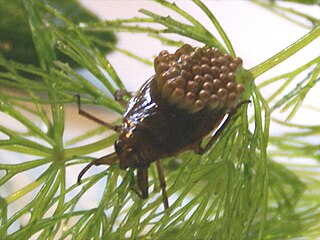
Appasus japonicus is a species of giant water bug in the family Belostomatidae. It is found in Japan and Korea, and has been much studied because it provides an example, rare among insects, of paternal care of the young. With the destruction of its typical habitat and its poor dispersal abilities, it has been listed as being an endangered species in Japan.
















